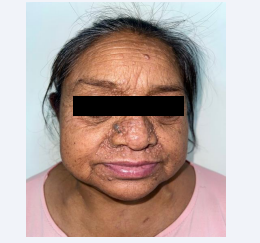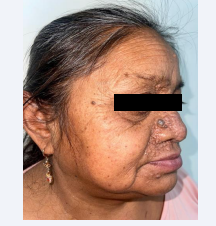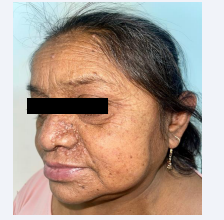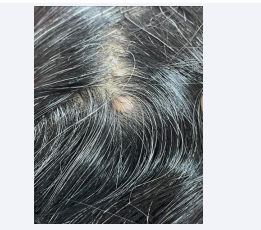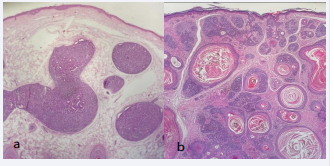From Tuberous Sclerosis to Brooke-Spiegler Syndrome: A Diagnostic Challenge Based on a Clinical Case
- 1. Dermatology Resident, Eugenio Espejo Specialties Hospital, Quito, Ecuador
- 2. Dermatologist, Eugenio Espejo Specialties Hospital, Quito, Ecuador
Abstract
Brooke-Spiegler Syndrome (BSS) is a rare autosomal dominant condition characterized by multiple adnexal skin neoplasms such as spiradenomas, cylindromas, and trichoepitheliomas. These tumors typically emerge during puberty and progressively increase in number and size throughout life. Due to clinical similarities with other dermatological conditions, diagnosis is challenging and requires skin biopsy and histological examination.
We report a 56-year-old woman with a 34-year history of asymptomatic cutaneous lesions on her face and scalp, unresponsive to topical tacrolimus and corticosteroids. Physical examination revealed several well-defined, skin-colored papular lesions on the central facial region and scalp. Biopsies confirmed the presence of trichoepithelioma and spiradenoma. The patient also had a significant family history of the same condition affecting multiple relatives.
This case underscores the importance of considering BSS in patients presenting with multiple adnexal tumors and a familial pattern of skin neoplasms. Early diagnosis is crucial due to the potential for malignant transformation in 5–10% of cases. Treatment remains challenging; although various modalities like surgical excision and laser therapy are used, recurrence and excessive scarring are common. Our patient responded favorably to erbium laser therapy.
KEYWORDS
- Brooke-spiegler syndrome
- Familial skin tumors
- Adnexal skin neoplasms
- Trichoepithelioma and spiradenoma
CITATION
López L, Félix C, Aguilar Y, Santofimio MV (2024) From Tuberous Sclerosis to Brooke-Spiegler Syndrome: A Diagnostic Challenge Based on a Clinical Case. JSM Clin Case Rep 12(4): 1248.
ABBREVIATIONS
BSS: Brooke-Spiegler Syndrome; CYLD: Cylindromatosis Gene
INTRODUCTION
Brooke-Spiegler Syndrome (BSS) is a rare autosomal dominant hereditary condition characterized by the development of multiple adnexal skin neoplasms, most commonly spiradenomas, cylindromas, and trichoepitheliomas (also known as cribriform trichoblastomas) [1,2]. The first tumors typically appear during puberty, with a slight predilection for females [3]. Throughout life, these tumors increase in both number and size [4]. Clinical differential diagnoses include several conditions involving multiple skin and/or scalp tumors, making this syndrome a diagnostic and histological challenge.
CASE REPORT
A 56-year-old female patient with a medical history of chronic kidney disease, hypertension, diabetes mellitus, and hypothyroidism. For the past 34 years, she has developed cutaneous lesions on her face and scalp, which have progressively increased in size and number. The lesions are asymptomatic. She has received topical treatments with tacrolimus and corticosteroids without any clinical improvement.
Physical examination revealed several well-defined, skin- colored papular neoformations located in the central facial region (Figures 1-3).
Figure 1: Well-defined, skin colored popular neoformations located in the central facial region.
Figure 2: The neoformations are of varying sizes, with the largest measuring 0.8mm in diameter, located on the right nasal wall.
Figure 3: Skin-colored papules with regular, well-defined borders, grouped to from a large plaque affecting the supra- and infra-palpebral regions, nose, and perioral area.
Additional isolated, skin-colored papules with regular borders were observed on the scalp (Figure 4).
Figure 4: Isolated skin-colored papules with regular, well-defined borders located on the scalp.
A skin biopsy was performed, resulting in diagnoses of trichoepithelioma and spiradenoma, respectively (Figure 5A,B).
Figure 5 A: Benign adnexal tumor characterized by a pattern in which numerous small glandular lumina are observed, lined by a single layer of basophilic epithelial cells and surrounded by another group with paler cytoplasm. It exhibits a trabecular pattern, encircled by eosinophilic cell chains. Compatible with spiradenoma.
B: Benign adnexal characterized by infundibular cysts filled with basophilic lamellar keratin intermingled with basaloid cords. Surrounding these cords and epithelial nests, rings of eosinophilic, sclerotic collagen can be observed. Compatible with trichoepithelioma.
The patient reports a significant family history of the same dermatological condition, affecting several relatives, including her father (deceased), four siblings, three children, and five nephews (Table 1).
Table 1: Family tree showing her father (deceased), four siblings, three children, and five nephews affected with BBS.
